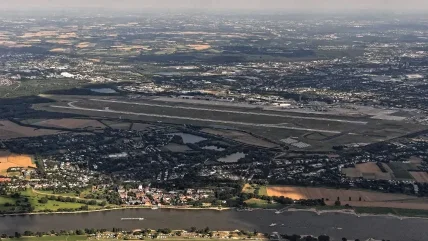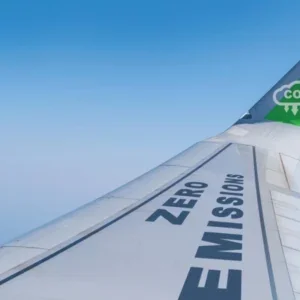
Counting the cranes on a city’s skyline is often said to be a good indicator of the economic performance of a country. Looking even higher at the planes flying overheard can also be used as a pretty accurate economic barometer. As the cycle of boom and bust sends share prices this way and that, air traffic closely matches the rise and fall of the stock ticker.
During the global economic downturn, the aviation sector was hit hard, with both cargo and passenger traffic plummeting. IATA reported that between January 2008 and January 2009, global passenger demand dropped by 5.6%, with Asia leading the way at 8.4%. The problem was further exacerbated by only a 2% cut in capacity in the same period, leading load factors to tumble to 72.8%, and profits to be slashed.
Since the worst of the recession passed, the recovery has been steady, if somewhat unspectacular, on a global scale. 2011 saw passenger traffic grow by 5.9%, while the cargo market contracted slightly by 0.8%. This somewhat uneven performance will continue in 2012, with IATA forecasting a 3.7% increase in revenues across the board.
This does not tell the whole story, however, with some regions performing significantly better than others.
China saw extremely strong domestic air travel demand in 2011, jumping more than 17% during 2010, and a capacity growth of more than 13%, helping to improve load factors in the country. This trend was closely followed by the other BRIC nations of India and Brazil. At a regional scale, demand growth was strongest in Latin America, rising by 10.2% in 2011, and in the Middle East, where traffic was up 8.9%; however, Europe struggled to match the pace of emerging markets, with Western Europe having particular difficulty, scoring no more than single-digit growth figures, country by country. IATA forecasts that this trend will continue into 2012, expecting no more than a 0.8% growth in traffic in France, 1.1% in the UK and 1.5% in Germany.
With such uncertainty in the recovery of the eurozone economies, and the threat of contagion among other EU nations, this has led to cautious forecasting of Europe’s air traffic prospects, causing airport operators and airlines across the continent to think laterally about how they can revitalise their growth prospects, and match their global counterparts in the race for the skies.
No longer able to go it alone, airlines, airports and, increasingly, tourism authorities, are having to work together to improve growth prospects. Obviously, the situation for each European country, its airports and airlines is unique, and dependent on the set of circumstances in which it finds itself. But no country in the European continent can afford for its neighbours to flounder, as is the interconnected nature of air travel.
With the Single European Sky initiative gaining ground, this will become even more pressing in the years ahead. Mark Brierley speaks to two leading European airport operators to find out how they are working to counter Europe’s sluggish recovery.
Mark Brierley: How can airports and airlines work together to adapt to this period of lower growth? Does the business model need to change to improve traffic?
Christoph Blume: In order to sustain periods of lower growth, Düsseldorf International Airport (DUS) took some significant decisions a number of years ago, which are paying off now: DUS has defined itself as a next-generation hub, meaning that it bundles the hub operations of Lufthansa and its Star Alliance partner airlines, as well as the hub operations of Air Berlin, soon to be a member of oneworld, both creating a significant amount of connecting traffic through the airport.
With more than 20 million passengers in 2011, DUS is still a convenient gateway to Europe.
Combining the hub operation with very strong origin and destination traffic – 18 million people live in our catchment area, making it the second-largest catchment in Europe – we are able to keep and even expand our network.
Michal Marzec: For over a year, we have been working with LOT Polish Airlines to develop the carrier’s hub at Chopin Airport. This has already yielded tangible results: a reduction of the minimum connection time to a record low of 30 minutes in the Schengen-Schengen traffic, changes to facilitate the transfer of passengers and baggage between planes without having to go through the terminal, and the increase in the frequency of use of passenger boarding bridges from 20% to 70%. All this resulted in a more than 15% growth in transfer traffic and a 5.6% increase in the total number of LOT passengers.
Let’s also not forget about our cooperation in launching and running the LOT Business Lounge ‘Polonez’, the newest and biggest executive lounge at Chopin Airport, which increased our revenue from above-standard passenger services by 50%.
LOT is the biggest airline in Warsaw, handling nearly half of all passenger traffic. Therefore, we work closely together regarding the introduction of slot coordination at Chopin Airport, which is set for the beginning of the coming summer season, as well as the preparations to accommodate the Boeing 787. Benefits of such initiatives are twofold: they help strengthen the airline’s position in the market and, at the same time, increase the importance of the airport. I think airports have no choice but to forge close business relationships and encourage flexible, effective cooperation. This is the only way both sides can succeed.
MB: What role can tourism authorities play in improving the situation? How can they work with airport operators?
MM: The importance of promoting the city and the entire region is immense, as the tourist popularity of the destination is one of the most crucial factors that determine the viability of a new route. At Chopin Airport, we try to be involved in the city’s promotional activities as much as we can – we include information about tourist attractions to be found in Warsaw in our promotional material, as well as on the internet, especially on our social media pages. We sneak in information about the capital into articles presenting Chopin Airport in international magazines.
We work closely with the two most important museums in Warsaw (Zacheta National Gallery of Art and the National Museum in Warsaw) to use the airport as a venue to popularise modern Polish art and the Warsaw art scene. We are now hosting an exhibition entitled ‘Attracted to Warsaw’ (Polish Warszawa ZAcheca) documenting the past and present of the capital.
I must admit, however, that we’re counting on the Warsaw authorities to be more active in this area. I’m under the impression that cities to which we are most often compared, Budapest and Prague, are still ahead of us in terms of recognisability and popularity among foreign tourists. If Warsaw were able to attract more visitors from Europe and beyond, the airport would benefit as well.
CB: Tourism authorities can offer attractive packages with local hoteliers and other providers in the area, and offer those to the airlines. As airports, we are somehow like catalysts bringing the local tourism authorities together with the relevant airlines. In the case of DUS, this has worked out quite well; for example, we have worked with UK carriers to bring tourists to the Düsseldorf Christmas markets in December – usually a period of lower traffic.
MB: Business travel is one sector bucking the wider trend. Do you think this will lead the recovery in other sectors?
CB: Business travel is traditionally strong at DUS due to the fact that the airport is located in the region known as the economic powerhouse of Germany: the metropolitan region Rhine-Ruhr. We have never experienced a downturn in other sectors. Over the last year, airlines have opened some interesting and unique leisure destinations, such as Curaçao, and new destinations in Turkey and Beirut.
MM: After the slowdown in 2009, Chopin Airport has bounced back. In 2010, we handled 8.7 million passengers, and more than 9.3 million the year after that, the second-best result in the airport’s history.
Forecasts for 2012 are even better; we expect to serve 9.6 million travellers, which will be our record high. I can confidently say that we’ve put the crisis behind us.
Chopin Airport’s main focus is on business passengers. Our services are directed toward passengers who are willing to pay for high quality. Less-demanding passengers may use the soon-to-open airport in Modlin, near Warsaw, which will be dedicated mainly to low-cost traffic. The two largest European carriers from this sector have already declared that they intend to operate from Modlin, which bodes well for the future.
Charter traffic is also on the rise at Chopin Airport. It’s enough to say that two charter airlines, Poland’s Enter Air and the Czech Travel Service, recorded the highest year-on- year passenger growth in 2011, up 253.3% and 82.5%, respectively. Both are among the five biggest operators at Chopin Airport.
Regional airports have also been successful. Out of ten regional airports, nine improved on the previous year, with a few achieving their best results to date. I’m certain that 2012 will be just as good, or perhaps even better, especially considering that in June thousands of fans will come to Warsaw to watch the European Football Championships, with most of them flying in. We are ready to welcome them.






